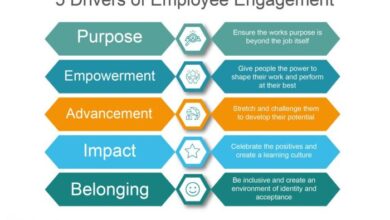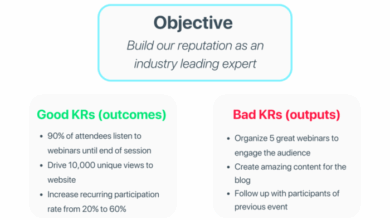
Employee recognition creating a culture of kudos – Employee recognition, creating a culture of kudos, is more than just a pat on the back. It’s a powerful tool for boosting morale, fostering a positive work environment, and driving impactful results. This exploration delves into the multifaceted world of employee recognition, from defining its core elements to implementing effective programs and overcoming potential challenges. We’ll discover how sincere appreciation, coupled with well-structured initiatives, can transform a company culture, leading to higher engagement, productivity, and retention.
We’ll examine different recognition methods, from formal awards to informal peer-to-peer praise. Understanding the importance of employee voice and tailoring programs to various company sizes will be key to creating a truly impactful recognition system. The article will also explore how to measure the success of these programs, highlighting actionable steps and real-world examples of successful implementations.
Defining Employee Recognition
Employee recognition is more than just a pat on the back; it’s a vital component of a thriving workplace culture. It acknowledges and appreciates the contributions of individuals, fostering a sense of value and belonging. Effective recognition programs motivate employees, boost morale, and enhance productivity. A well-structured approach encourages a positive work environment where employees feel valued and motivated to excel.A comprehensive definition of employee recognition encompasses various forms and methods, encompassing both formal and informal expressions of appreciation.
Recognition can range from a simple “thank you” to elaborate awards ceremonies, depending on the context and the employee’s contribution. Understanding the nuances of recognition, including its various forms and the importance of sincerity, is crucial for building a culture of appreciation.
Formal Recognition
Formal recognition programs are structured systems designed to acknowledge significant contributions. They often involve specific criteria, procedures, and rewards. These programs can be invaluable in highlighting exemplary performance and creating a sense of shared accomplishment. Formal recognition is usually publicized, creating visibility for the recipient and inspiring others. Examples include employee of the month awards, performance bonuses, or public acknowledgments in company meetings.
Formal recognition, when implemented effectively, reinforces desired behaviors and values.
Informal Recognition
Informal recognition is a more spontaneous and immediate form of appreciation. It often involves simple expressions of gratitude, such as verbal praise, a handwritten note, or a small gift. These expressions are typically immediate and personal, fostering a more connected and supportive work environment. Informal recognition is often more frequent and can be implemented by anyone in the organization, thereby encouraging a broader sense of appreciation within the team.
It can be a valuable tool in daily interactions, promoting a culture of appreciation.
Sincerity and Genuine Appreciation
The sincerity and genuineness behind recognition programs are paramount. A forced or insincere gesture can be detrimental to morale and diminish the impact of the recognition itself. Employees can readily discern authenticity, and a program perceived as inauthentic can have a negative effect on the workplace. Genuine appreciation is not about the reward itself, but about acknowledging the value of the employee’s contribution.
Recognition should feel genuine and impactful.
Leadership’s Role in Fostering a Culture of Recognition
Leaders play a critical role in establishing and nurturing a culture of recognition. They set the tone for the entire organization by modeling the desired behaviors. Leaders should proactively acknowledge and appreciate the contributions of their team members, demonstrating that recognition is valued. This fosters a ripple effect, encouraging other employees to engage in acts of recognition as well.
Leaders must also actively participate in formal recognition events and provide constructive feedback in a supportive and appreciative manner.
Recognition Methods
A well-designed recognition program encompasses a range of methods, catering to various preferences and contributions.
| Recognition Method | Description | Frequency | Target Audience |
|---|---|---|---|
| Verbal praise | Direct, positive feedback on performance or effort. | Daily/Weekly | All employees |
| Written thank you | Handwritten or emailed notes expressing gratitude. | Weekly/Monthly | Individual employees or teams |
| Public acknowledgment | Recognition during meetings, newsletters, or social media. | Monthly/Quarterly | Specific achievements, team accomplishments |
| Gift cards/small tokens | Small gifts or vouchers as a token of appreciation. | Monthly/Special occasions | Employees who have gone above and beyond |
Creating a Culture of Kudos
Cultivating a workplace where appreciation is a daily norm, not a fleeting event, requires deliberate effort. It’s about shifting from a reactive “thank you” to a proactive culture of recognition that fuels employee engagement and fosters a positive work environment. This goes beyond simply acknowledging good work; it’s about creating a system that reinforces desired behaviors and celebrates individual and team achievements.
This culture needs careful planning and consistent nurturing.A culture of kudos isn’t just about patting people on the back; it’s about creating a system where employees feel valued and motivated to contribute their best. It’s about acknowledging small wins and major accomplishments, reinforcing positive behaviors, and making recognition a regular part of the work routine. This fosters a sense of community and shared purpose, strengthening team dynamics and encouraging innovation.
Key Elements of a Kudos Culture, Employee recognition creating a culture of kudos
A strong culture of appreciation hinges on several key elements. These include clear communication channels for expressing gratitude, readily available avenues for recognition, and a demonstrable commitment from leadership to champion the program. Leaders must model the desired behavior, reinforcing the importance of appreciation and acknowledgement in the daily interactions. A robust system for recognizing both individual and team contributions is essential.
Furthermore, consistent reinforcement of the culture through training and reminders helps to ensure its longevity.
Strategies for Daily Recognition
To make recognition a daily occurrence, it’s crucial to move beyond infrequent awards or annual employee appreciation days. This means integrating recognition into the daily workflow, making it an ingrained part of team interactions and leadership practices. One effective strategy is to incorporate peer-to-peer recognition programs, enabling colleagues to acknowledge each other’s contributions. Furthermore, consider using instant messaging platforms, email, or even dedicated recognition boards for quick and easy acknowledgment.
By weaving recognition into everyday interactions, the appreciation becomes automatic and integral to the workplace dynamic.
The Importance of Employee Voice
Employee input is vital in shaping any successful recognition program. Gathering employee feedback on existing programs and ideas for improvement can significantly enhance program effectiveness. Surveys, focus groups, or informal feedback sessions can provide invaluable insights into what motivates and inspires employees. This participatory approach ensures the program resonates with the workforce, leading to increased engagement and positive impact.
Effective Communication Strategies
Clear and consistent communication is paramount to fostering a culture of kudos. Regular updates about recognition initiatives, examples of previous recognitions, and stories of employee achievements can help keep the momentum going. Leadership should actively participate in recognizing employees, demonstrating their commitment to the program and highlighting the positive impact of appreciation on team dynamics. Public acknowledgment, such as posting on company intranets or sharing success stories in team meetings, amplifies the message and reinforces the culture.
5 Actionable Steps to Create a Culture of Kudos
A culture of kudos is built, not imposed. Here are 5 actionable steps to initiate and sustain this positive environment:
- Establish Clear Recognition Criteria: Define specific criteria for recognition, ensuring they align with company values and goals. This clarity helps ensure fairness and consistency in the process.
- Implement a Multi-Channel Recognition System: Offer multiple ways for employees to express appreciation, from informal shout-outs to formal awards programs. This variety caters to different communication styles and preferences.
- Involve Employees in the Process: Actively solicit employee feedback on recognition initiatives and incorporate their ideas into the program. This participatory approach fosters ownership and buy-in.
- Lead by Example: Leaders should model the desired behaviors by recognizing and appreciating their team members’ contributions regularly. This visible support fosters a culture of appreciation throughout the organization.
- Sustain the Momentum: Regularly review and refine the recognition program to ensure it remains relevant and effective. This ongoing evaluation and improvement ensures the culture of kudos remains vibrant and meaningful.
Recognition Programs and Initiatives

Cultivating a culture of appreciation extends beyond simply saying “thank you.” Effective employee recognition programs are strategic tools that foster a positive work environment, boost morale, and drive performance. They are crucial for attracting and retaining top talent in today’s competitive job market. These programs go beyond the occasional pat on the back and become ingrained in the company’s DNA, shaping a more engaged and productive workforce.Recognition programs aren’t a one-size-fits-all solution.
Understanding different company structures and sizes is key to creating programs that resonate with your employees and achieve their intended objectives. Tailoring these programs to specific needs, whether it’s a small startup or a large corporation, is paramount to ensuring their impact. Rewards should be carefully considered, reflecting the values and goals of the company.
Different Recognition Program Types
Recognition programs can be categorized into various types, each with its own strengths and weaknesses. Effective recognition often combines different approaches to create a comprehensive strategy. Peer-to-peer recognition, for instance, empowers employees to acknowledge and reward each other, fostering a sense of camaraderie and teamwork. Manager-led initiatives, on the other hand, provide a structured approach, often linked to performance goals.
Company-wide awards, celebrating outstanding contributions across the organization, build a shared sense of accomplishment and reinforce company values.
Tailoring Programs to Company Size and Structure
Small businesses can leverage peer-to-peer recognition platforms to encourage collaboration and foster a strong sense of community. Manager-led recognition, focusing on specific departmental achievements, can also be highly effective. Large corporations, with their diverse departments and teams, might find company-wide awards, celebrating exceptional performance across various units, to be the most impactful. These programs should align with the company’s structure and communication channels, maximizing their reach and impact.
Reward Systems for Employee Recognition
Various reward systems can be implemented to support recognition programs. These systems can range from tangible rewards like gift cards and bonuses to intangible rewards like public acknowledgments and opportunities for professional development. Tangible rewards can be linked to performance targets, while intangible rewards can focus on non-monetary recognition and employee development. Careful consideration of the cultural context and employee preferences is crucial for a successful program.
For example, in some cultures, public recognition might be highly valued, while in others, private acknowledgment might be preferred.
Criteria for Selecting Deserving Employees
Several criteria can be used to select deserving employees for recognition. Consistent high-quality performance, exceeding expectations, and going above and beyond in their roles are key indicators. Innovation and creativity in problem-solving are also crucial factors. Examples include exceeding sales targets, implementing innovative solutions, or demonstrating exceptional customer service. A well-defined selection process, aligned with company values and goals, ensures fairness and credibility.
Examples of Recognition Programs
| Program Name | Target Audience | Recognition Type | Benefits |
|---|---|---|---|
| “Employee Spotlight” | All employees | Public acknowledgment, feature in company newsletter | Enhances visibility, fosters a sense of community, boosts morale |
| “Peer-to-Peer Kudos” | All employees | Digital platform for colleagues to recognize each other | Promotes teamwork, increases engagement, fosters positive interactions |
| “Manager’s Choice Award” | Specific departmental employees | Written commendation, small gift | Recognizes exceptional performance, strengthens manager-employee relationship |
| “Quarterly Achievement Award” | All employees | Company-wide celebration, monetary award | Motivates high performance, highlights company achievements, fosters a culture of excellence |
Measuring the Impact of Recognition

Recognizing employee contributions is crucial, but measuring the impact of those efforts is equally vital. Effective recognition programs not only boost morale and engagement but also demonstrably improve performance and retention. A well-structured approach to measurement allows companies to fine-tune their programs, ensuring they are achieving their intended goals.Understanding the quantifiable and qualitative effects of recognition initiatives provides valuable data to optimize strategies and demonstrate ROI.
This allows for data-driven adjustments to existing programs and the creation of new, more effective ones.
Employee recognition is key to fostering a positive work environment, creating a culture of kudos and appreciation. It’s amazing how much a simple “thank you” can boost morale. However, it’s also important to remember the darker side of technology, as highlighted by recent reports that Iran is using Huawei gear to snoop on citizens report iran uses huawei gear to snoop on citizens.
This highlights the need for vigilance, not just in the workplace, but in our digital lives. Ultimately, recognizing and appreciating employees helps build a stronger, more resilient team.
Metrics for Assessing Recognition Program Effectiveness
A comprehensive approach to measuring recognition program effectiveness involves evaluating various metrics. These metrics range from quantifiable employee feedback to observable shifts in behavior and performance. Data collection should be ongoing and adaptable to capture the nuances of employee response.
Quantifiable Data for Measuring Impact
Several quantifiable metrics can help gauge the success of recognition programs. Employee satisfaction surveys, for instance, can provide a direct measure of how employees feel about the recognition program’s impact on their experience. These surveys can ask specific questions about whether the recognition program has increased feelings of appreciation, motivation, and job satisfaction. Tracking changes in key performance indicators (KPIs) is another valuable method.
For example, a rise in productivity or a decrease in employee turnover can be strong indicators of a successful program.
Qualitative Data for Measuring Impact
Qualitative data, though less tangible, provides crucial insights into the impact of recognition. Employee feedback gathered through focus groups, interviews, or open-ended survey questions can reveal the “why” behind observed changes. For example, an employee might express how a particular recognition program helped them feel valued and motivated, leading to improved performance. Tracking the frequency and nature of employee nominations for recognition can also reveal valuable insights into the program’s effectiveness.
Tracking Employee Engagement and Satisfaction
Tracking employee engagement and satisfaction related to recognition is crucial. This can be accomplished by regularly monitoring employee feedback, conducting pulse surveys, and using employee feedback tools. Tracking comments made in recognition nominations, and using these comments to understand what aspects of the program are most impactful, are also essential. This feedback loop allows for adjustments to the program as needed, ensuring its continued relevance and impact.
Employee recognition, fostering a culture of kudos, is crucial for boosting morale and productivity. Knowing how to effectively acknowledge top performers is key, and the the top performers field guide offers valuable insights into identifying and rewarding those who consistently exceed expectations. This, in turn, creates a positive work environment where everyone feels appreciated and motivated to contribute their best.
Key Indicators of a Successful Recognition Program
Several key indicators point to a successful recognition program. High employee satisfaction scores, increased employee retention rates, a rise in employee engagement scores, and demonstrable improvements in key performance indicators (KPIs) are all positive signs. Furthermore, a noticeable shift in employee behavior, such as increased collaboration or initiative, demonstrates the program’s positive influence on the workplace culture.
Table: Metrics for Measuring Recognition Program Effectiveness
| Metric | Description | Target Value | Measurement Method |
|---|---|---|---|
| Employee Satisfaction Score | Overall satisfaction with recognition program | 80% or higher | Employee satisfaction surveys, feedback forms |
| Employee Turnover Rate | Percentage of employees leaving the company | Below industry average | Tracking employee departures, comparing to industry benchmarks |
| Employee Engagement Score | Level of engagement and commitment | Above 70% | Employee engagement surveys, pulse surveys |
| Key Performance Indicator (KPI) Improvement | Positive change in relevant metrics (e.g., sales, productivity) | Increase of 10% or more | Tracking relevant KPIs before and after program implementation |
Overcoming Challenges in Implementing Recognition: Employee Recognition Creating A Culture Of Kudos
Building a culture of employee recognition is a powerful way to boost morale and performance. However, implementing such programs often faces hurdles. Understanding these challenges and developing effective solutions is key to success. Successful recognition programs aren’t just about giving out awards; they require a strategic approach that considers various factors.Implementing a robust recognition program is not a simple task.
It requires careful planning, consistent execution, and a commitment from all levels of the organization. This involves addressing potential roadblocks, including budget limitations, resistance to change, and a lack of overall buy-in. Overcoming these challenges is crucial for creating a truly effective and sustainable recognition culture.
Common Obstacles to Recognition Program Implementation
Recognizing employees is essential for maintaining a positive and productive work environment. However, several obstacles can hinder the successful implementation of recognition programs. These obstacles include budget limitations, resistance to change, and a lack of buy-in from leadership and employees.
- Budget Constraints: Financial limitations can restrict the scope and scale of recognition initiatives. For instance, awarding expensive gifts or providing lavish travel incentives may not be feasible for organizations with limited budgets. Finding cost-effective ways to acknowledge and reward employees is crucial for making recognition programs accessible to all.
- Resistance to Change: Employees may be resistant to adopting new recognition systems, particularly if they are unfamiliar with the benefits. Addressing concerns and showcasing the positive impact of recognition programs is crucial for gaining acceptance and fostering a culture of appreciation. Clearly communicating the purpose and benefits of the program to all employees helps alleviate concerns and promotes participation.
- Lack of Buy-in: Without support from leadership, recognition programs can struggle to gain traction. If senior management doesn’t champion the initiative, employees may perceive it as a superficial gesture rather than a genuine commitment to valuing their contributions. Demonstrating the link between recognition and improved performance, through clear communication and measurable results, is crucial for gaining support and buy-in from all levels.
Addressing Challenges with Strategic Solutions
Developing strategies to address the obstacles mentioned above is essential for long-term success. Solutions need to be tailored to specific organizational contexts.
- Budget Constraints: Implementing creative and cost-effective solutions is key. Examples include public recognition through company newsletters or internal announcements, small gift cards, or opportunities for extra time off. Employee-nominated awards, where employees recognize their peers, can also be cost-effective and foster a sense of camaraderie.
- Resistance to Change: Clearly communicating the rationale behind the recognition program and its benefits is crucial. Highlighting how recognition programs contribute to employee morale, productivity, and overall company success can help overcome resistance. Actively soliciting feedback from employees during the program’s development phase can help build buy-in and address concerns.
- Lack of Buy-in: Enlisting leadership support and actively promoting the program from the top down is essential. Highlighting successful case studies from other companies can provide compelling evidence of the program’s potential impact. Involving leadership in the program’s rollout, by participating in recognition events, can demonstrate the program’s importance and promote its success.
Maintaining a Consistent Recognition Culture
Sustaining a strong recognition culture requires ongoing effort and consistent implementation.
- Regular Recognition Events: Scheduling regular recognition events, such as monthly or quarterly celebrations, can maintain momentum and keep the recognition program top-of-mind. Regular reminders and follow-ups are key to maintaining consistency.
- Feedback Mechanisms: Establishing feedback mechanisms, such as surveys or suggestion boxes, allows employees to provide input and suggestions for improvement, ensuring the program remains relevant and valuable.
- Celebrating Milestones: Regularly recognizing employee achievements, milestones, and contributions keeps the focus on recognition and appreciation.
Case Studies of Successful Recognition Programs
Several companies have successfully navigated the challenges of implementing recognition programs. Their experiences offer valuable insights and strategies. For example, Google’s emphasis on employee well-being, including recognition, has been linked to high employee satisfaction and retention rates.
Overcoming Challenges: A Table of Solutions
| Challenge | Description | Potential Solution | Success Measurement |
|---|---|---|---|
| Budget Constraints | Limited financial resources for recognition initiatives. | Implement creative, cost-effective solutions like peer-to-peer recognition, employee-of-the-month awards, or public acknowledgments. | Track employee feedback on the perceived value of the recognition methods. |
| Resistance to Change | Employees may not readily embrace a new recognition program. | Clearly communicate the program’s benefits and actively solicit feedback during development. Showcase success stories of other companies. | Track employee participation rates and measure improvements in morale and engagement. |
| Lack of Buy-in | Insufficient support from leadership can hinder program success. | Involve leadership in the program’s development and implementation. Highlight the positive impact of recognition on performance and company culture. | Measure leadership engagement in recognition events and the program’s adoption by different teams. |
| Maintaining Consistency | Ensuring ongoing program effectiveness. | Establish a schedule for regular recognition events, incorporate feedback mechanisms, and maintain consistent communication about the program’s value. | Track employee participation rates, satisfaction scores, and improvements in team dynamics. |
Recognition for Specific Employee Contributions
Recognizing individual and team achievements is crucial for fostering a positive and productive work environment. It’s not enough to simply acknowledge good work; targeted recognition for specific contributions strengthens those behaviors and motivates further excellence. This approach goes beyond generic praise, focusing on the particular effort and impact of each individual or team.Specific recognition for contributions like innovation, teamwork, or problem-solving boosts morale and demonstrates a genuine appreciation for the effort invested.
This targeted approach encourages continued positive actions and strengthens the overall company culture.
Recognizing Innovation
Recognizing innovative contributions requires a clear definition of what constitutes innovation within the company. This could include developing new products, processes, or approaches that significantly improve efficiency or effectiveness. A robust system for evaluating and documenting innovative ideas is essential. Awarding “Innovation Champion” titles or providing grants for further development are effective methods for recognizing these efforts. This can involve a formal proposal review process or an open forum where employees share ideas.
Recognizing Teamwork
Teamwork is a cornerstone of many successful organizations. Recognizing team achievements highlights the collaborative spirit and the collective effort needed to achieve goals. This often involves team-based projects or initiatives. Recognizing the team’s performance as a whole is crucial; a celebratory lunch, team outing, or a team-building activity can be powerful motivators. Individual contributions within the team should also be acknowledged.
Recognizing Problem-Solving
Problem-solving is a vital skill for any organization. Recognizing employees who effectively identify and resolve issues is crucial for encouraging this behavior. Examples include developing solutions to operational bottlenecks or implementing improvements that save time or resources. Internal problem-solving contests or dedicated problem-solving recognition programs can be effective tools.
Recognizing Exceeding Expectations
Employees who consistently go above and beyond their job descriptions often drive significant positive change. Recognizing their efforts is crucial to sustaining this exceptional performance. Examples include taking on additional responsibilities, mentoring colleagues, or volunteering for extra projects. Public acknowledgment, promotions, or increased responsibilities are effective ways to reward such dedication. A written letter of appreciation or a public announcement can also be very meaningful.
Employee recognition, fostering a culture of kudos, is crucial for a thriving workplace. However, sometimes leaders, like those described in the article “how the reality distortion field is hurting Ballmer and could kill us” here , get so caught up in their own vision that they lose sight of reality. This distorted view can ultimately hinder progress, even if they’re initially lauded for their efforts.
Ultimately, a culture of genuine recognition, not just self-serving praise, is key to a positive work environment.
Celebrating Milestones and Achievements
Celebrating milestones and achievements is a vital aspect of employee recognition. This can involve celebrating project completions, departmental successes, or individual performance milestones. A celebratory event, such as a small gathering, a company-wide email, or a public announcement, can create a strong sense of accomplishment and boost morale. It’s also essential to acknowledge and reward consistent high performance over time.
Methods for Recognizing Contributions
| Contribution Category | Example | Recognition Method | Supporting Evidence |
|---|---|---|---|
| Innovation | Developing a new software feature that improved efficiency by 20% | “Innovation Champion” award, bonus, public announcement | Documented impact, peer reviews, management feedback |
| Teamwork | Successfully completing a complex project exceeding deadlines and budget targets | Team celebration lunch, team outing, individual performance reviews | Project documentation, team feedback, project manager reports |
| Problem-Solving | Identifying and resolving a critical supply chain issue that saved the company $50,000 | “Problem Solver” award, bonus, company-wide email | Detailed analysis of the issue, impact on costs, manager feedback |
| Exceeding Expectations | Mentoring a junior employee, volunteering for extra projects, consistently exceeding sales quotas | Written letter of appreciation, promotion, increased responsibilities | Peer reviews, manager feedback, performance metrics |
Recognition and Employee Engagement
Employee recognition isn’t just a nice-to-have; it’s a crucial component of a thriving workplace. A robust recognition program can significantly impact employee engagement, fostering a positive work environment and boosting overall company performance. It’s a powerful tool for building a stronger, more connected, and more productive team.A culture of recognition directly correlates with increased employee engagement. When employees feel valued and appreciated for their contributions, they’re more likely to be invested in their work and the success of the company.
This translates into higher levels of productivity, better collaboration, and ultimately, a more positive and profitable business.
Correlation Between Recognition and Engagement
Recognition acts as a powerful catalyst for boosting employee engagement. Employees who feel appreciated are more likely to be invested in their work, demonstrate higher levels of initiative, and contribute more effectively to team goals. A strong connection between recognition and engagement leads to a more positive and productive work environment.
Recognition and Morale Boost
Recognition directly impacts employee morale. Positive feedback and acknowledgment of accomplishments create a sense of fulfillment and accomplishment. This, in turn, boosts motivation and enthusiasm, leading to increased job satisfaction and a more positive overall attitude towards work. Employees are more likely to embrace challenges and contribute their best when they feel appreciated.
Recognition and Productivity
Recognition programs can significantly boost productivity. When employees feel valued and appreciated, they’re more motivated to perform at their best. The positive reinforcement created through recognition programs encourages a proactive and focused approach to work, leading to higher quality output and faster completion of tasks. A motivated workforce is a productive workforce.
Recognition and Employee Retention
A robust recognition program is a key component of successful employee retention strategies. Employees who feel valued and appreciated are more likely to remain with the company long-term. Recognition fosters a sense of belonging and commitment, which can help reduce employee turnover and save the company time and resources associated with recruitment and training. Recognition can act as a strong retention tool.
Fostering a Sense of Belonging and Value
Recognition plays a vital role in fostering a sense of belonging and value among employees. When employees are acknowledged for their contributions, they feel more connected to the team and the company. This sense of belonging fosters a collaborative and supportive work environment where individuals feel appreciated and valued, leading to greater employee satisfaction and engagement.
Examples of Improved Company Culture
Recognition programs can dramatically improve company culture. By creating a culture of appreciation, companies can foster a more positive and supportive work environment. This can be seen in increased collaboration, improved communication, and a stronger sense of teamwork. Examples include employee of the month programs, peer-to-peer recognition platforms, and personalized thank-you notes. These programs demonstrate the company’s commitment to its employees, reinforcing a positive and productive work atmosphere.
Closing Notes
In conclusion, fostering a culture of kudos through employee recognition is an investment in your company’s future. By implementing thoughtful and consistent programs, you can cultivate a more engaged, productive, and ultimately, more successful workforce. Remember, genuine appreciation and a focus on employee well-being are cornerstones of a thriving work environment. The benefits are clear: increased morale, improved productivity, and a more positive company culture.






